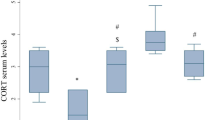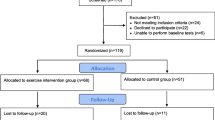Abstract
We hypothesized that intense exercise training (forced swimming for 30 min, 5 days/week) may enhance the progression of mammary carcinogenesis through the involvement of stress hormones, such as catecholamines and prolactin, which can promote breast cancer. After the appearance of the DMBA-induced tumors in Sprague-Dawley rats, the effect was evaluated of exercise-induced stress (with or without administration of the hormone melatonin) on the survival time, tumor multiplicity, and tumor growth until the death of the animals. In a second set of experiments, after one month of exercise, the NK cells count in blood, and the plasma concentrations of catecholamines and prolactin were determined. Although no significant change was found in either the survival time of the rats or the tumor multiplicity, exercise significantly increased the tumor growth rate. Stress was confirmed by the enhanced adrenaline and prolactin concentrations in the blood of the exercised rats. Exercise-induced stress did not change the percentage of NK cells in the tumor-bearing rats. Melatonin counteracted the increased tumor growth, returning the prolactin and adrenaline concentrations to their optimal physiological levels in the exercised tumor-bearing rats, thus confirming an “anti-stress” role of this hormone.
In conclusion, intense exercise-induced stress enhances mammary carcinogenesis through the involvement of adrenaline and prolactin. The results also confirmed a role of melatonin as a therapeutic aid against breast cancer in general, and in particular during situations of stress.
Similar content being viewed by others
References
Hoffman-Goetz L, Husted J: Exercise and breast cancer: review and critical analysis of the literature. Can J Appl Physiol 19: 237–252, 1994
Thompson HJ: Effect of exercise intensity and duration on the induction of mammary carcinogenesis. Cancer Res 54: 1960s–1963s, 1994
Willer A: Reduction of the individual cancer risk by physical exercise. Onkologie 26: 283–289, 2003
Colditz GA, Feskanich D, Chen WY, Hunter DJ, Willett WC: Physical activity and risk of breast cancer in premenopausal women. Brit J Cancer 89: 847–851, 2003
Verloop J, Rookus MA, van der Kooy K, van Leeuwen FE: Physical activity and breast cancer risk in women aged 20–54 years. J Natl Cancer Inst 92: 128–135, 2000
Macneil B, Hoffman-Goetz L: Exercise training and tumor metastasis in mice: influence of time of exercise onset. Anticancer Res 13: 2085–2088, 1993
Thompson HJ: Effects of physical activity and exercise on experimentally-induced mammary carcinogenesis. Breast Cancer Res Treat 46: 135–141, 1997
Westerlind KC, McCarty HL, Schultheiss PC, Story R, Reed AH, Baier ML, Strange R: Moderate exercise training slows mammary tumor growth in adolescent rats. Eur J Cancer Prev 12: 281–287, 2003
Hoffman-Goetz L: Physical activity and cancer prevention: Animal-tumor models. Med Sci Sports Exerc 35: 1828–1833, 2003
Cohen LA, Kendall ME, Meschter C, Epstein MA, Reinhandt J, Zang E: Inhibition of rat mammary tumorigenesis by voluntary exercise. In Vivo 7: 151–158, 1993
Clevenger CV, Furtii PA, Llankinson SE, Schuler LA: The role of prolactin in mammary carcinoma. Endocrine Reviews 24: 1–27, 2003
Vonderhaar BK: Prolactin involvement in breast cancer. Endocr Relat Cancer 6: 389–404, 1999
Drell TL, Joseph J, Lang K, Niggemann B, Zaenker KS, Entschladen F: Effects of neurotransmitters on the chemokinesis and chemotaxis of MDA-MB-468 human breast carcinoma cells. Breast Cancer Res Treat 80: 63–70, 2003
Vazquez SM, Pignataro O, Luthy IA: Alpha2-adrenergic effect on human breast cancer MCF-7 cells. Breast Cancer Res Treat 55: 41–49, 1999
Anisimov VN: The role of pineal gland in breast cancer development. Crit Rev Onclo Hematol 46: 221–234, 2003
Sánchez-Barceló EJ, Cos S, Fernández R, Mediavilla MD: Melatonin and mammary cancer: A short review. Endocr Relat Cancer 10: 153–159, 2003.
Reiter RJ: Mechanisms of cancer inhibition by melatonin. J Pineal Res 37: 213–214, 2004
Maestroni GJ, Conti A: The pineal neurohormone melatonin stimulates activated CD4+, Thy-1+ cells to release opioid agonist (s) with immunoenhancing and anti-stress properties. J Neuroimmunol 28: 167–176, 1990
Sáez MC, Barriga C, García JJ, Rodríguez AB, Ortega E: Effect of the preventive-therapeutic administration of melatonin on mammary tumor-bearing animals. Mol Cell Biochem 268: 25–31, 2005
Loscher W, Mevissen M, Haussler B: Seasonal influence on 7,12-dimethylbenz[a]anthracene-induced mammary carcinogenesis in Sprague-Dawley rats under controlled laboratory conditions. Pharmacol Toxicol 81: 265–270, 1997
Kubatka P, Bojkova B, M cikova-Kalicka K, Mnichova-Chamilova M, Adamekova E, Ahlers I, Ahlersova E, Cermakova M: Effects of tamoxifen and melatonin on mammary gland cancer induced by N-methyl-N-nitrosourea and by 7,12-dimethylbenz(a)anthracene, respectively, in female Sprague-Dawley rats. Folia Biol (Praha). 47: 5–10, 2001
Ortega E, Collazos ME, Barriga C, De la Fuente M: Effect of physical activity stress on the phagocytic process of peritoneal macrophages from old guinea pigs. Mech Ageing Dev 65: 157–165, 1992
Thompson HJ, Ronan AM, Ritacco KA, Tagliaferro AR, Meeker D: Effect of exercise on the induction of mammary carcinogenesis. Cancer Res 48: 2720–2723, 1988
Aoyama H, Mori N, Mori W: Anti-glucocorticoid effect of melatonin on adult rats. Acta Pathol Jpn 37: 1143–1148, 1987
Pinilla L, Gonzalez LC, Tena-Sempere M, Aguilar E: Interactions between serotoninergic and aminoacidergic pathways in the control of PRL secretion in prepubertal male rats. J Physiol Biochem 57: 237–244, 2001
Russo J, Russo IH: Atlas and histologic classification of tumors of the mammary gland. J Mammary Gland Biol Neoplasia 5: 187–200, 2000
Kendall AR, Mahne-Giangreco M, Carpenter CL, Ganz PA, Bernstein L: Influence of exercise activity on quality of life in long-term breast cancer survivors. Qual Life Res 14: 361–371, 2005
Pinto BM, Frierson GM, Rabin C, Trunzo JJ, Marcus BH: Home-based physical activity intervention for breast cancer patients. J Clin Oncol 23: 3577–3587, 2005
Lotzerich H, Fehr HG, Appell HJ: Potentiation of cytostatic but not cytolytic activity of murine macrophages after running stress. Int J Sports Med 11: 61–65, 1990
Peters C, Lotzerich H, Niemeir B, Schule K, Uhlenbruck G: Exercise, cancer and the immune response of monocytes. Anticancer Res 15: 175–179, 1995
Galvao DA, Newton RU: Review of exercise intervention studies in cancer patients. J Clin Oncol 23: 899–909, 2005
Oliveira SA, Christos PJ: The epidemiology of physical activity and cancer. Ann NY Acad Sci 833: 79–90, 1997
Shamley DR, Barker K, Simonite V, Beardshaw A: Delayed versus immediate exercises following surgery for breast cancer: a systematic review. Breast Cancer Res Treat 90: 263–271, 2005
Ben-Eliyahu S, Yirmiya R, Liebeskind JC, Taylor AN, Gale RP: Stress increase metastatic spread of mammary tumor in rats: evidence for mediation by the immune system. Brain Behav Immun 5: 193–205, 1991
Cheung SY, Yuen MT, Choi HL, Chen HK, Huan Y, Chen S, Chan FL: An expression study of hormone receptors in spontaneously developed, carcinogen-induced and hormone-induced mammary tumors in female Noble rats. Int J Oncol 22: 1383–1395, 2003
Bartsch C, Bartsch H, Buchberger A, Stieglitz A, Effenberger-Klein A, Kruse-Jarres JD, Besenthal I, Rokos H, Mecke D: Serial transplants of DMBA-induced mammary tumors in Fischer rats as a model system for human breast cancer. VI. The role of different forms of tumor-associated stress for the regulation of pineal melatonin secretion. Oncology 56: 169–176, 1999
Shakhar G, Ben-Eliyahu S: In vivo β-adrenergic stimulation suppresses natural killer activity and compromises resistance to tumor metastasis in rats. J Immunol 160: 3251–3258, 1998.
Kishi A, Takamori Y, Ogawa K, Takano S, Tomita S, Tanigawa M, Niman M, Kishida T, Fujita S: Differential expression of granulysin and perforin by NK cells in cancer patients and correlation of impaired granulysin expression with progression of cancer. Cancer Immunol Immunother 50: 604–614, 2002
Nanmark U, Basse P, Johanson BR, Kuppen P, Kjergaard J, Hokland M: Morphological studies of effector cell-microvessel interactions in adoptive immunotherapy in tumor-bearing animals. Nat Immun 15: 78–86, 1996–1997
ThyagaRajan S, Madden KS, Stevens SY, Felten DL: Anti-tumor effect of L-deprenyl is associated with enhanced central and peripheral neurotransmission and immune reactivity in rats with carcinogen-induced mammary tumors. J Neuroimmunol 109: 95–104, 2000
Hoffman-Goetz L, Apter D, Demark-Wahnefried W, Goran MI, McTiernan A, Reichman ME: Possible mechanisms mediating an association between physical activity and breast cancer. Cancer 83: 621–628, 1998
Thompson HJ, Westerlind KC, Snedden J, Briggs S, Singh M: Exercise intensity dependent inhibition of 1-methyl-1-nitrosourea induced mammary carcinogenesis in female F-344 rats. Carcinogenesis 16: 1783–1786, 1995
Gillette CA, Zhu Z, Westerlind KC, Melby CL, Wolfe P, Thompson HJ: Energy availability and mammary carcinogenesis: effect of calorie restriction and exercise. Carcinogenesis 18: 1183–1188, 1997
Sánchez-Barceló EJ, Cos S, Fernández R, Mediavilla MD, Martínez-Campa C, Gonzánlez A, Alonso-González C: Melatonin-estrogen interactions in breast cancer. J Pineal Res 38: 217–222, 2005
Reiter RJ, Tan D, Mayo JC, Sainz RM, Leon J, Czarnocki Z: Melatonin as an antioxidant: Biochemical mechanisms and pathophysiological implications in humans. Acta Biochim Pol 50: 1129–1146, 2003
Kang DH: Oxidative stress, DNA damage, and breast cancer. AACN Clin Issues 13: 540–549, 2002
Thompson HJ: Effect of treadmill exercise intensity on hepatic glutathione content and its relevance to mammary tumorigenesis. J Sports Med Phys Fitness 32: 59–63, 1992
Author information
Authors and Affiliations
Corresponding author
Rights and permissions
About this article
Cite this article
Sáez, M.d.C., Barriga, C., García, J.J. et al. Exercise-induced stress enhances mammary tumor growth in rats: Beneficial effect of the hormone melatonin. Mol Cell Biochem 294, 19–24 (2007). https://doi.org/10.1007/s11010-005-9067-5
Received:
Accepted:
Published:
Issue Date:
DOI: https://doi.org/10.1007/s11010-005-9067-5




